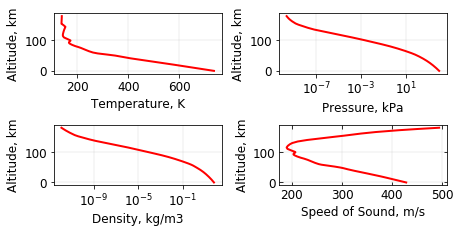Example - 02 - Atmosphere
In this example, you will learn to use add an atmosphere model to planets.
Let us re-use the code from example-01 to create a planet object for Venus.
[1]:
from AMAT.planet import Planet
planet = Planet("VENUS")
We are now ready to add an atmosphere model to the planet object.
AMAT stores atmospheric data in the form of look up tables located in ~root/atmdata. Typically, data is stored in the following format.
#Z(m) |
Temp(K) |
Pres (Nm2) |
rho(kgm3) |
a (m/s) |
|---|---|---|---|---|
0 |
735.30 |
9.209E+06 |
6.479E+01 |
428.03 |
1000 |
727.70 |
8.645E+06 |
6.156E+01 |
425.46 |
2000 |
720.20 |
8.109E+06 |
5.845E+01 |
422.88 |
3000 |
712.40 |
7.601E+06 |
5.547E+01 |
420.27 |
4000 |
704.60 |
7.120E+06 |
5.262E+01 |
417.63 |
5000 |
696.80 |
6.666E+06 |
4.987E+01 |
415.09 |
[2]:
# the atmosphere model provided in atmdata/Venus/venus-gram-avg.dat.
# The columns for height, Temp, pressure, density are 0, 1, 2, 3
planet.loadAtmosphereModel('../atmdata/Venus/venus-gram-avg.dat', 0 , 1 ,2, 3)
[3]:
# Let us now use the checkAtmProfiles function to inspect the atmospheric profiles.
planet.checkAtmProfiles()

[4]:
# Compute the scale height at the Venusian surface for illustration.
# planet.density_int is the interpolation function created by planet object
# when atmosphere model is loaded.
planet.scaleHeight(0, planet.density_int)
[4]:
16127.792366356383
Congratulations! Your planet now has an atmosphere model. In the next example, we will compute aerocapture trajectories for a vehicle flying in the Venusian atmosphere.